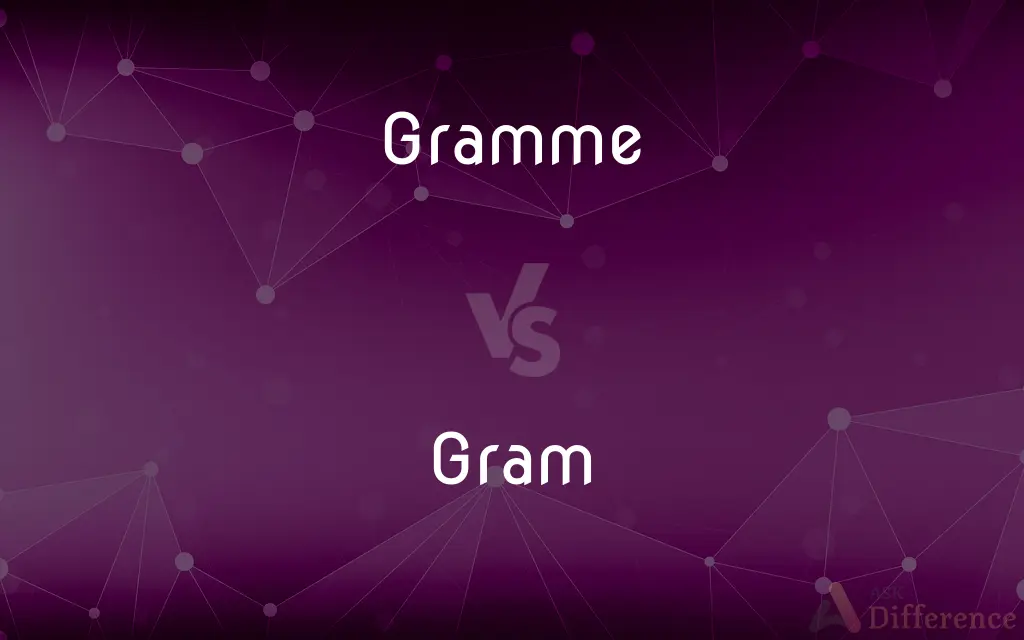Gramme vs. Gram — What's the Difference?
Edited by Tayyaba Rehman — By Urooj Arif — Updated on April 7, 2024
Gramme is an older spelling mainly used in British English, signifying a unit of mass. Gram, the modern and globally accepted term, denotes the same measure but is preferred in scientific and international contexts.

Difference Between Gramme and Gram
Table of Contents
ADVERTISEMENT
Key Differences
Gramme is an earlier form of the term used primarily within British English contexts, historically referring to a unit of mass in the metric system equivalent to one thousandth of a kilogram. On the other hand, gram is the modern spelling and internationally recognized term for the same measurement. It's used widely in science, nutrition, and everyday contexts worldwide, showcasing its universal acceptance.
While gramme might still appear in historical documents or in certain British texts, gram has become the standard form in scientific literature, educational materials, and international standards. This shift underscores the global movement towards standardization in measurements to facilitate clearer communication and avoid confusion.
Gramme, reflecting its age and regional usage, is less commonly encountered in contemporary discourse, particularly in scientific and international settings. In contrast, gram is used ubiquitously, not only in scientific documents but also in everyday situations, such as grocery shopping or cooking, making it a fundamental part of daily communication across cultures.
The usage of gramme over gram can sometimes signal a text’s age or the author's geographical or cultural background. Meanwhile, the use of gram demonstrates adherence to the International System of Units (SI), which aims at uniformity in scientific and educational communication.
In educational settings, students are taught using the term gram from a young age, emphasizing the importance of a unified system of measurement. This educational practice contrasts with earlier generations that might have been taught the term gramme, especially in British or Commonwealth countries, highlighting a shift towards global standardization in measurement terms.
ADVERTISEMENT
Comparison Chart
Spelling
Older, primarily British usage
Modern, universally accepted
Usage
Historical documents, British texts
Scientific literature, daily use worldwide
Context
Less common, regional
Ubiquitous, international standards
Education
Taught in historical or regional context
Standard in modern educational systems
International Standardization
Reflects older practices
Adheres to International System of Units (SI)
Compare with Definitions
Gramme
Once preferred in British English for scientific measures.
The recipe called for 500 grammes of flour.
Gram
Taught universally in schools across the globe.
Children learn to measure using grams from an early age.
Gramme
A unit of mass equal to one thousandth of a kilogram.
The antique scale measured in grammes.
Gram
The accepted unit of mass in the metric system, equivalent to one thousandth of a kilogram.
The nutrition label showed 10 grams of protein.
Gramme
Its usage can indicate the author's regional background.
Her British upbringing was evident when she wrote 250 grammes.
Gram
Predominant in contemporary scientific and educational materials.
The science textbook listed measurements in grams.
Gramme
Frequently found in older scientific literature.
The manuscript listed substances in grammes.
Gram
Recognized and promoted by the International System of Units.
The SI unit for mass is the kilogram, but grams are more practical for everyday use.
Gramme
Part of the metric system, though less commonly used today.
Schools taught the metric system, including grammes.
Gram
Used worldwide in science, nutrition, and everyday life.
He added 20 grams of sugar to the recipe.
Gramme
Variant of gram1.
Gram
The gram (alternative spelling: gramme; SI unit symbol: g) is a metric system unit of mass. Originally defined as "the absolute weight of a volume of pure water equal to the cube of the hundredth part of a metre [1 cm3], and at the temperature of melting ice" (later at 4 °C, the temperature of maximum density of water).
Gramme
(UK) gram unit of mass
Gram
A metric unit of mass equal to one thousandth (10-3) of a kilogram. See Table at measurement.
Gramme
Same as Gram the weight.
Gram
Any of several legumes, such as the chickpea, bearing seeds used as food.
Gramme
A metric unit of weight equal to one thousandth of a kilogram
Gram
The seeds of such a plant.
Gram
A grandmother.
Gram
A unit of mass equal to one-thousandth of a kilogram. Symbol: g.
Gram
A leguminous plant grown for its seeds, especially the chickpea.
Gram
(uncountable) The seeds of these plants.
Gram
Grandmother.
Gram
(US) graham
Gram
(colloquial) 'gram
Gram
Angry.
Gram
The East Indian name of the chick-pea (Cicer arietinum) and its seeds; also, other similar seeds there used for food.
Gram
A metric unit of weight equal to one thousandth of a kilogram
Gram
Danish physician and bacteriologist who developed a method of staining bacteria to distinguish among them (1853-1938)
Common Curiosities
Why is gram preferred over gramme?
Gram is the modern, globally recognized term, aligning with international standards for scientific measurement.
How does a gram compare to a gramme?
A gram and a gramme represent the same unit of mass; the difference lies mainly in spelling and regional usage.
Can I use gramme in scientific documents?
It's recommended to use gram to adhere to current international standards and avoid confusion.
Is gramme still used today?
While less common, gramme may still appear in some British texts or historical documents.
What is a gramme?
A gramme is an older spelling for a unit of mass, now more commonly spelled as "gram."
How do educational systems approach the term gramme?
Modern educational systems primarily teach "gram" to align with international standards.
Which countries might still use gramme?
Some British or Commonwealth countries might still have texts referencing gramme, though its usage is declining.
How is gram used in daily life?
Gram is used for measuring weight in cooking, nutrition labeling, and science.
Are grammes and grams interchangeable?
Yes, in terms of measurement, but gram is preferred for consistency and clarity.
Why did the spelling change from gramme to gram?
The change reflects a global move towards standardization in scientific measurement.
Is there a difference in meaning between gramme and gram?
No, the meaning is the same; the difference lies in usage and preference.
Has the spelling gramme affected international communication?
The shift to "gram" has facilitated clearer and more unified international communication in science and education.
Do older scientific texts use gramme?
Yes, older texts, especially from the 19th and early 20th centuries, may use gramme.
What's the origin of the term gramme?
Both gramme and gram derive from the French word "gramme," introduced in the late 18th century.
What impact does using gram have on global standardization?
Using gram supports international efforts for a consistent and unified system of measurement, enhancing communication and education worldwide.
Share Your Discovery

Previous Comparison
Greatly vs. Significantly
Next Comparison
Pig vs. ShoatAuthor Spotlight
Written by
Urooj ArifUrooj is a skilled content writer at Ask Difference, known for her exceptional ability to simplify complex topics into engaging and informative content. With a passion for research and a flair for clear, concise writing, she consistently delivers articles that resonate with our diverse audience.
Edited by
Tayyaba RehmanTayyaba Rehman is a distinguished writer, currently serving as a primary contributor to askdifference.com. As a researcher in semantics and etymology, Tayyaba's passion for the complexity of languages and their distinctions has found a perfect home on the platform. Tayyaba delves into the intricacies of language, distinguishing between commonly confused words and phrases, thereby providing clarity for readers worldwide.
















































